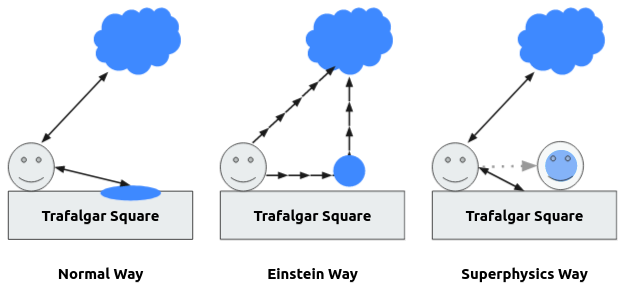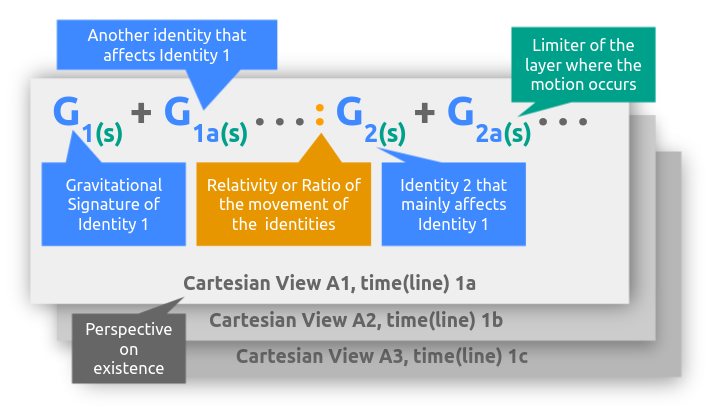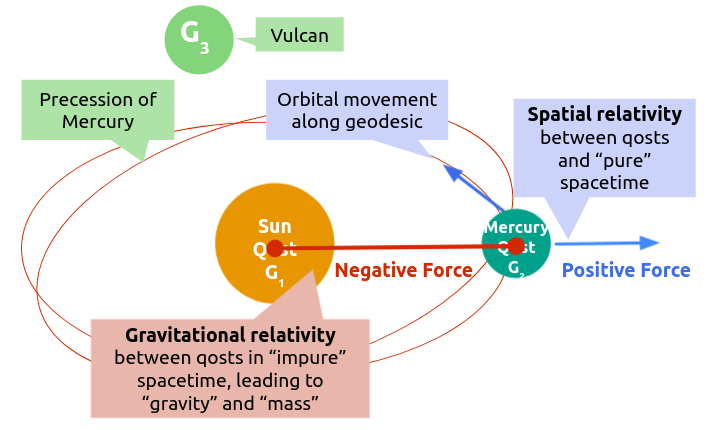Spatial Relationality
December 30, 2021 4 minutes • 746 words
Table of contents
Spatial Relationality is deals with the movement between of quanta of spacetime (qosts) as heavenly bodies and material things.
Our theory of Unviersal Relationality
This paradigm then leads to new technologies as:
- teleportation (instant state-change) and
- levitation (gradual state-change).
It renders quantum fields and some of Einstein’s tensors useless, just as Copernicus and Kepler rendered the spheres of Ptolemy useless.
More importantly, it discards the sophistical ideas of wormholes, singularities, and dark matter (in its current definition) to be replaced with vortices of the 5 Elements or Layers.
How does General Relativity lead to Absurd Wormholes?
In his book Relativity, Einstein proposes a strange way to find the space between an observer on Trafalgar square and a cloud above it. He takes a pole, connects it to both the cloud and Trafalgar square PERPENDICULARLY. This then, he claims, would remove the need to have a rigid Trafalgar square as basis.

Few people seemed to notice that this method is totally arbitrary. It creates a kind of space (and time) that can bend or be perpendicular to anything the imagination thinks of.
To confine this arbitrariness, Einstein uses c or light (which everyone perceives in the same way) to make empirical observations (that are common to all humans) possible. This c is then balanced by a cosmological constant as the medium or arena for the c.
This arbitrariness, established as a science, then necessarily leads to fanciful imaginings like singularities, wormholes, and dark matter to plug the holes and differences between the imagination and the actual nature of the universe. This is similar to Aristotle and Ptolemy creating concentric spheres around the Earth.
No one seemed to ask how would Einstein’s system work in total darkness. How would a blind man erect a pole to a cloud that he couldn’t see?
A Different Way: Experiential
The proper and natural way to judge the space of a cloud on Trafalgar square is to know the nature of both the cloud and Trafalgar square. In this way, the proper location is determined by the relative differences of those two natures. A blind observer can know the cloud by the thunder it creates and how it compares to other sounds from Trafalgar square which he learns by experience.
Assuming Trafalgar square has four squares A1, A2, B1, and B2. The person has existed in all squares and has heard thunder above each one, as well as above all the other squares. This leads to 16 total experiences.

In this way, the person in A1 who hears a thunder in B2 will know its location by extracting the relation of the cloud and the area from his memory. This relation is aethereal relativity, which becomes gravitational relativity when applied to the spatial layer.
This method does away with the use of light as the measuring rod, and so it can throw away c and lambda while still being within the nature of the universe. In Western philosophy, the obsession with light comes from Aristotle who put sight as the supreme sense. This is opposite of the sightless observations proposed by Pythagoras and Socrates (as well as Hinduism, Buddhism, and Taoism) which we are advancing.
Instead of c, it uses the relation of the person in two states (A1 and B2) with the state of the cloud in B2.
Notice how this system is similar to quantum mechanics which assigns a probability to each location through a ‘path integral’ formulation.
Gravitational Relativity
We replace the Einstein tensor with a Kepler tensor and replace equality with a ratio sign. Former constants, such as the Newtonian G, c, and lambda are put under s which represents the spatial layer.
The stress-energy tensor is then a new G which usually represents mass.

We then apply his for Mercury’s precession:
- Leverrier’s solution is G1(gravitational) + G1a(gravitational) : G2(gravitational)
- This uses gravitational relativity using a hypothetical planet Vulcan
- Einstein’s solution is G1(spatial) : G2(spatial)
- This uses spatial relativity using the speed of light

This shows that Leverrier’s solution is valid if Vulcan existed, just as Einstein’s solution is valid if Mercury’s core is large. It shows that Mercury’s large core gives it its elliptical orbit just as comets have an elliptical orbit. We then infer that Mercury’s precession and ellipse come from its core, giving it the dynamics of a comet or asteroid more than a planet.






